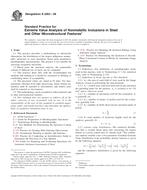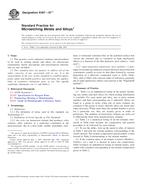Potrebujeme váš súhlas na využitie jednotlivých dát, aby sa vám okrem iného mohli ukazovať informácie týkajúce sa vašich záujmov. Súhlas udelíte kliknutím na tlačidlo „OK“.
ASTM E712-80(2009)
Standard Practice for Laboratory Screening of Metallic Containment Materials for Use With Liquids in Solar Heating and Cooling Systems (Withdrawn 2018)
Automaticky preložený názov:
Štandardné praktiky pre laboratórne skríning kovových obalu reaktora materiálov pre použitie s tekutinami v solárny ohrev a chladenie
NORMA vydaná dňa 1.4.2009
Informácie o norme:
Označenie normy: ASTM E712-80(2009)
Poznámka: NEPLATNÁ
Dátum vydania normy: 1.4.2009
Kód tovaru: NS-47754
Počet strán: 8
Približná hmotnosť: 24 g (0.05 libier)
Krajina: Americká technická norma
Kategória: Technické normy ASTM
Kategórie - podobné normy:
Anotácia textu normy ASTM E712-80(2009) :
Keywords:
corrosion, deterioration, high pressure, immersion, metallic containment materials, solar collector, solar heating and cooling, Containment systems/applications, Corrosion--metals/alloys, Corrosion--solar devices, Crevice corrosion, Deterioration, Dip test, Electrolytic cleaning, Immersion--solar devices, Pressure testing--solar devices, Solar heating/cooling systems, Transmittance and reflectance--solar devices, Tube loop test, ICS Number Code 77.040.99 (Other methods of testing metals)
Doplňujúce informácie
| Significance and Use | ||||||||||||||||||||||||||||||||||||||||||
|
At this time, none of these tests has been demonstrated to correlate with field service. It is essential that consideration be given to the appropriate pairing of metal and fluid since these procedures do not restrict the selection of either the containment material or the fluid for testing. Likewise, knowledge of the corrosion protection mechanism and the probable mode of failure of a particular metal is helpful in the selection of test conditions and the observation, interpretation, and reporting of test results. The design of solar heating and cooling systems strongly affects the applicability of the results of the laboratory screening tests. Therefore, the results of these laboratory procedures should be confirmed by component and systems testing under actual or simulated service conditions. Table 1 is provided to assist in an orderly consideration of the important factors in testing. It is expected that the user of the test procedure will investigate a range of test times and temperatures for the containment material in a metal/fluid pair, and adjust the time and temperature of testing as necessary. Note 1—Corrosion, whether general or localized, is a time-dependent phenomenon. This time dependence can show substantial nonlinearity. For example, formation of a protective oxide will diminish corrosion with time, while certain forms of localized attack accelerate with time. The minimum time required for a test to provide a corrosion rate that can be extrapolated for the prediction of long-term performance varies widely, depending on the selection of metal and fluid, and on the form of corrosion attack. Therefore, it is not possible to establish a single minimum length of test applicable to all materials and conditions. However, it is recommended that for the tests described in this practice, a test period of no less than 30 days be used. Furthermore, it is recommended that the effect of time of testing be evaluated to detect any significant time dependence of corrosion attack. It is essential for the meaningful application of these procedures that the length of the test be adequate to detect changes in the nature of the fluid that might significantly alter the corrosivity of the fluid. For example, exhaustion of chemical inhibitor or chemical breakdown of the fluid may occur after periods of months in selected cycles of operation. Note 2—Many fluids that may be considered for solar applications contain additives to minimize the corrosivity of the fluid. Many such additives are useful only within a specific concentration range, and some additives may actually accelerate corrosion if the concentration falls below a critical level. Depletion kinetics can be a strong function of the exposed metal surface area. Therefore, for tests involving fluids with such additives, consideration must be given to the ratio of metal surface area to fluid volume as it may relate to an operating system. TABLE 1 Significant Variables in Evaluation of Containment Material/Heat Transfer Fluid PairsA
A In this table, the subdivisions are not necessarily related in correspondence to their lettering. |
||||||||||||||||||||||||||||||||||||||||||
| 1. Scope | ||||||||||||||||||||||||||||||||||||||||||
|
1.1 This practice covers several laboratory test procedures for evaluating corrosion performance of metallic containment materials under conditions similar to those that may occur in solar heating and cooling systems. All test results relate to the performance of the metallic containment material only as a part of a metal/fluid pair. Performance in these laboratory test procedures, taken by itself, does not necessarily constitute an adequate basis for acceptance or rejection of a particular metal/fluid pair in solar heating and cooling systems, either in general or in a particular design. This practice is not intended to preclude the use of other screening tests, particularly when those tests are designed to more closely simulate field service conditions. 1.2 This practice describes apparatus and procedures for several tests, any one or more of which may be used to evaluate the deterioration of the metallic containment material in a metal/fluid pair. The procedures are designed to permit simulation, heating, and cooling systems including (1) operating full flow, (2) stagnant full, (3) stagnant partial fill, and (4) stagnant empty. Particular attention should be directed to properly reflecting whether the system is open or closed to atmosphere. 1.3 This practice covers the following six tests:
1.4 Practice A is concerned with the interaction of metal and fluid when both are at the same temperature with no heat transfer from one to the other. It is regarded as useful for plumbing, pumps, tanking, etc., but of less significance, taken by itself, for collector panels. Practices B and F are concerned with the deterioration of the metal when there is transfer of heat from the metal into the heat transfer fluid. These practices are especially applicable to the collector panel. Practice C permits a variety of tests but is especially useful in relation to systems that experience high temperatures, or are closed to the atmosphere. Practices D and E evaluate specific corrosion problems that may be associated with particular metal/fluid pairs and particular designs of systems and components. 1.5 This standard does not purport to address all of the safety concerns, if any, associated with its use. It is the responsibility of the user of this standard to establish appropriate safety and health practices and determine the applicability of regulatory limitations prior to use. |
||||||||||||||||||||||||||||||||||||||||||
| 2. Referenced Documents | ||||||||||||||||||||||||||||||||||||||||||
|
||||||||||||||||||||||||||||||||||||||||||
Podobné normy:
Historická
1.10.2012
Historická
1.9.2011
Historická
1.2.2008
Historická
1.5.2011
Historická
1.6.2013
Historická
1.5.2007
Odporúčame:
Aktualizácia technických noriem
Chcete mať istotu, že používate len platné technické normy?
Ponúkame Vám riešenie, ktoré Vám zaistí mesačný prehľad o aktuálnosti noriem, ktoré používate.
Chcete vedieť viac informácií ? Pozrite sa na túto stránku.



 ASTM E1351-01(2012)..
ASTM E1351-01(2012).. ASTM E1916-11
ASTM E1916-11 ASTM E2283-08
ASTM E2283-08 ASTM E3-11
ASTM E3-11 ASTM E340-13
ASTM E340-13 ASTM E407-07e1
ASTM E407-07e1
 Cookies
Cookies
